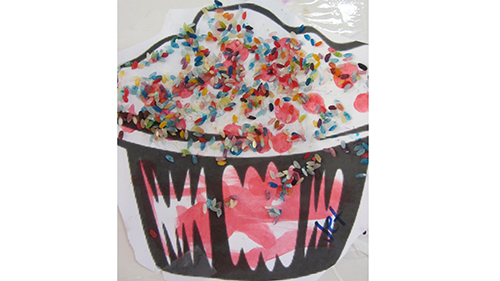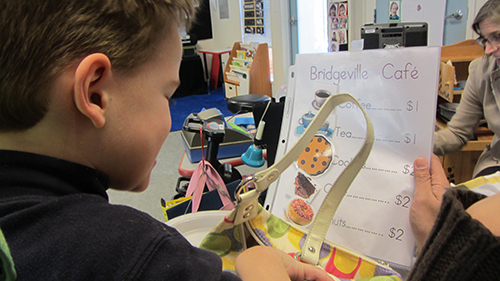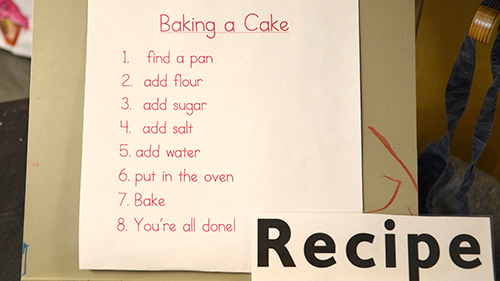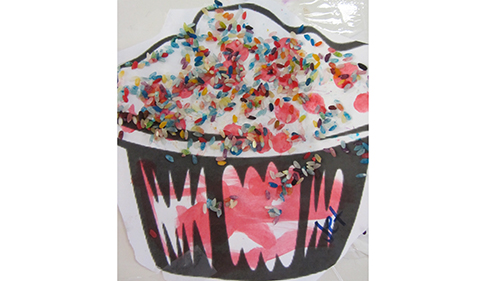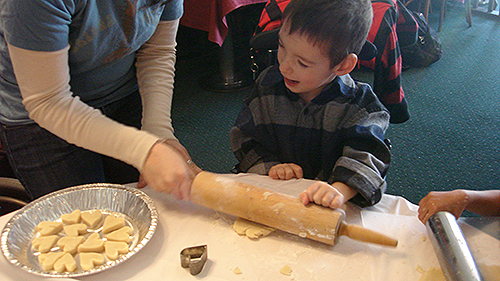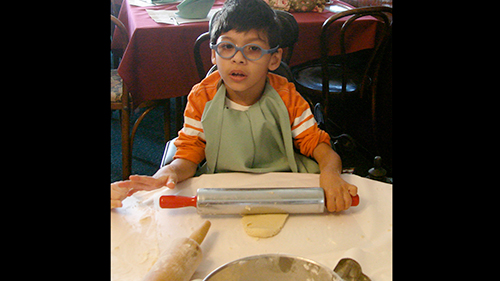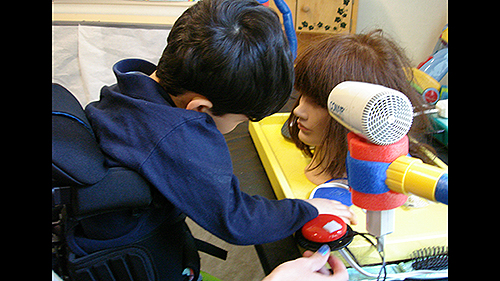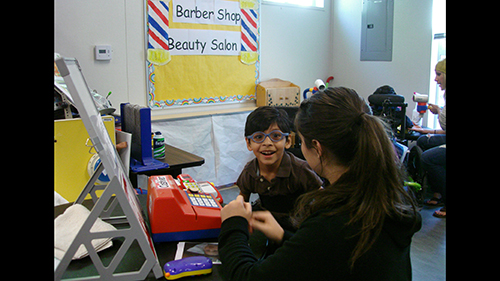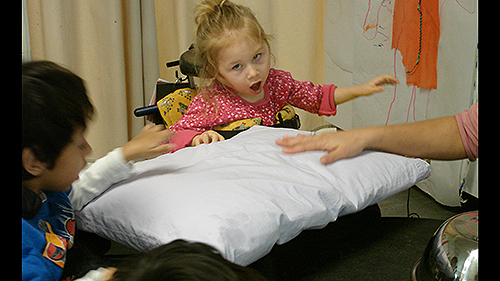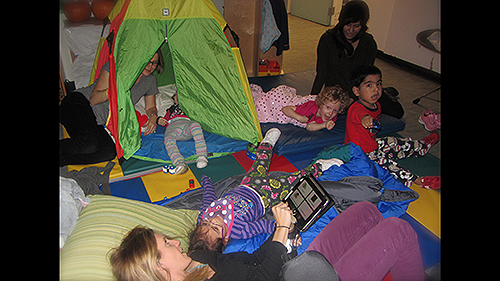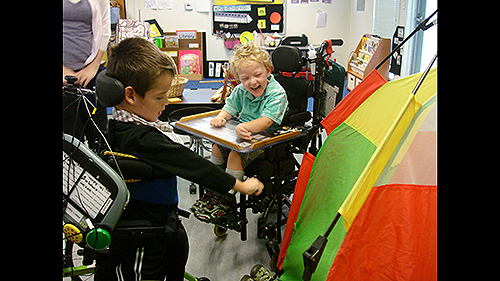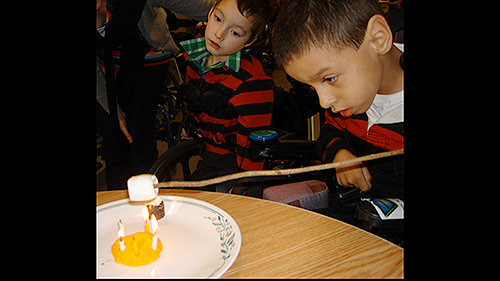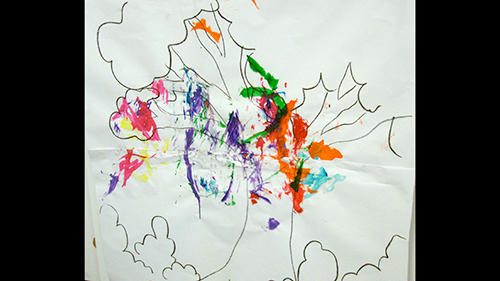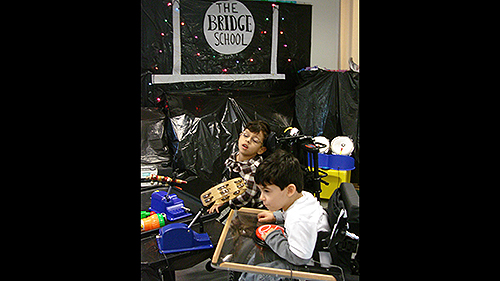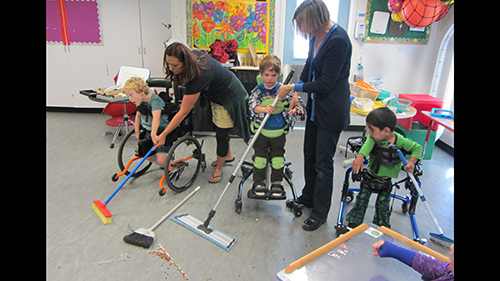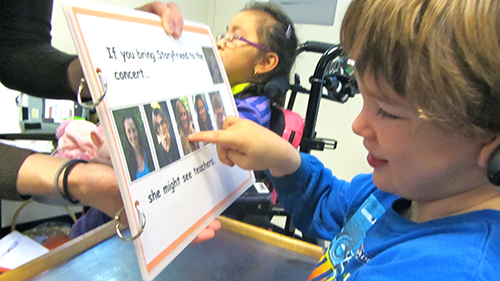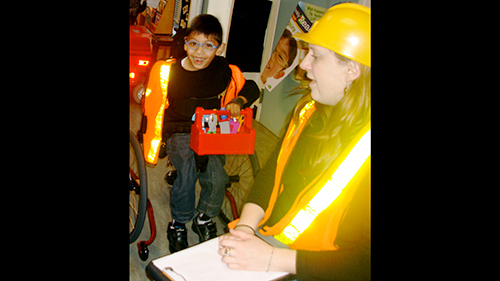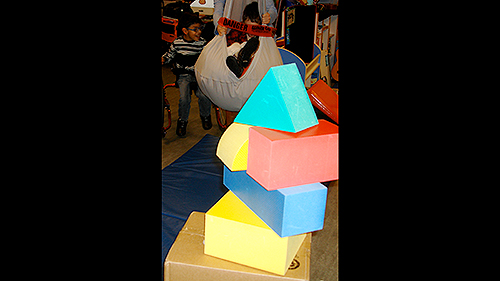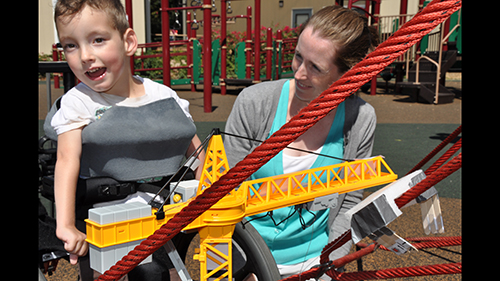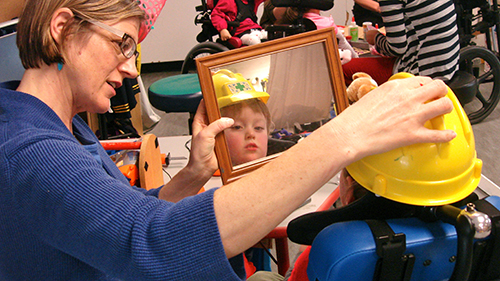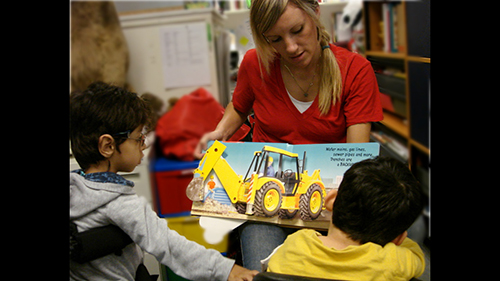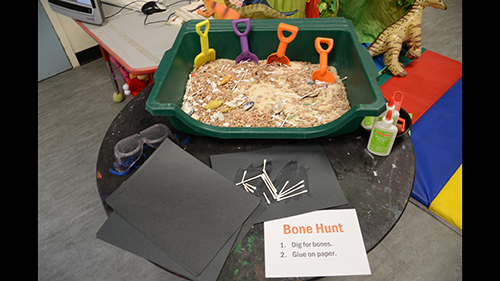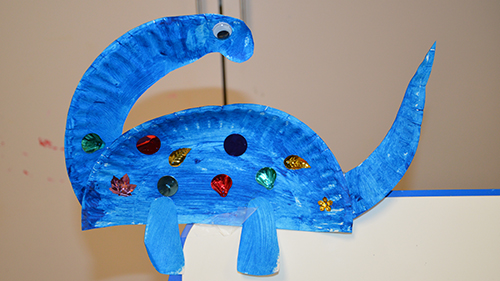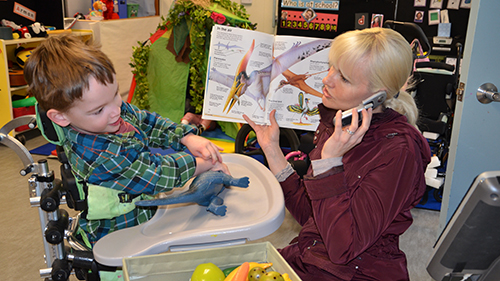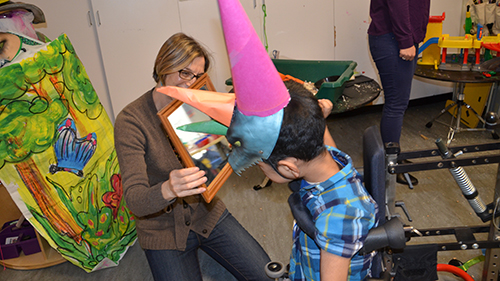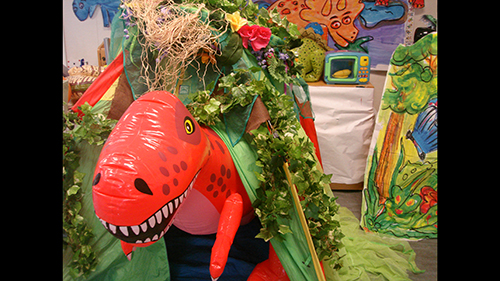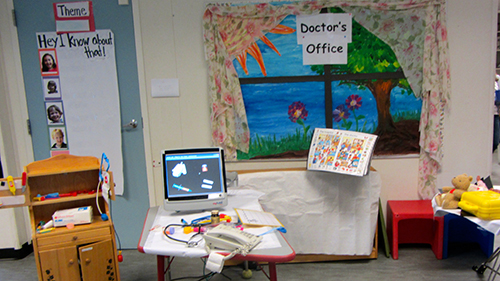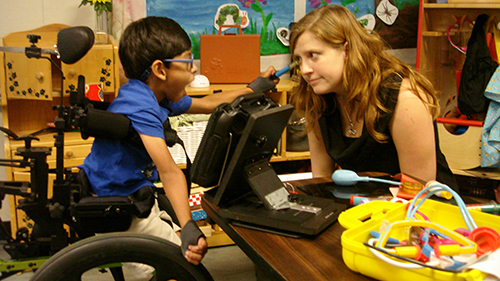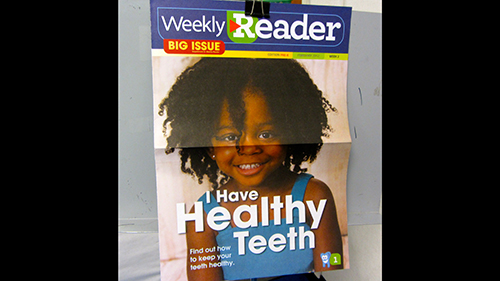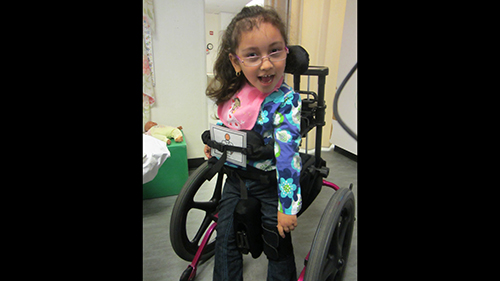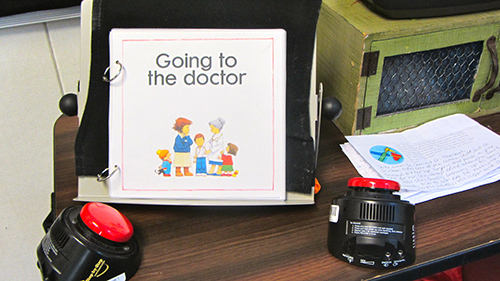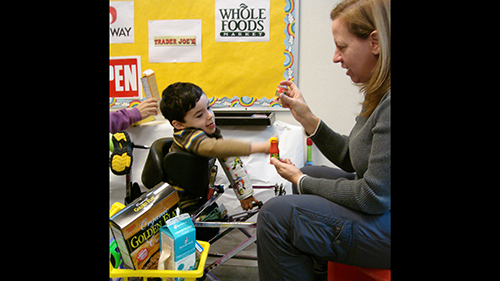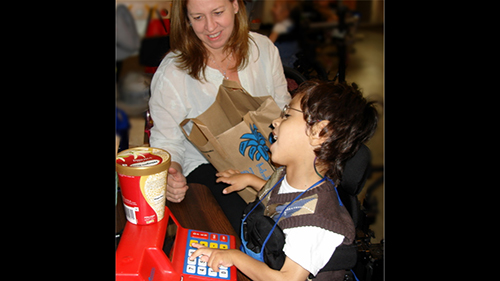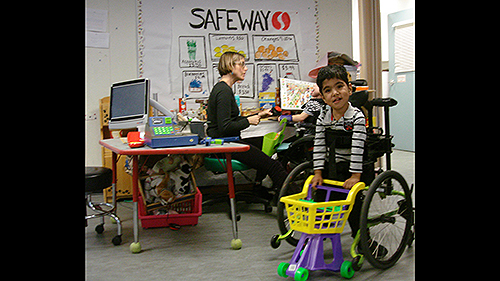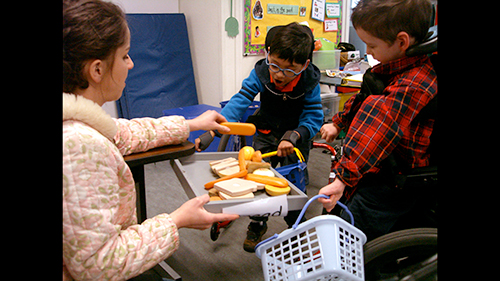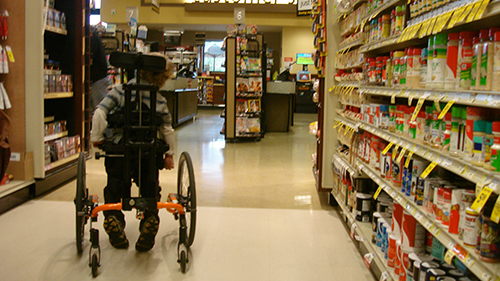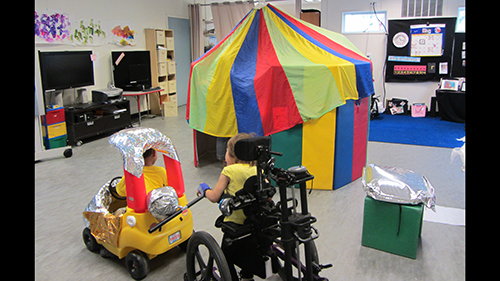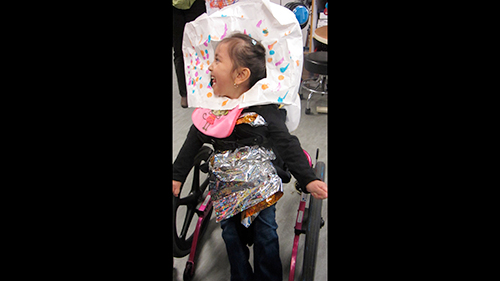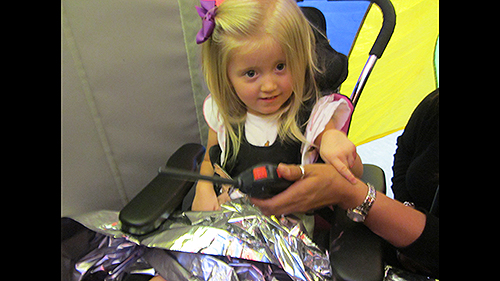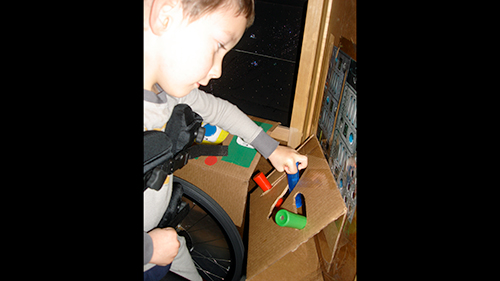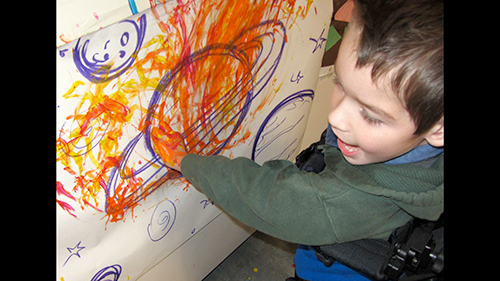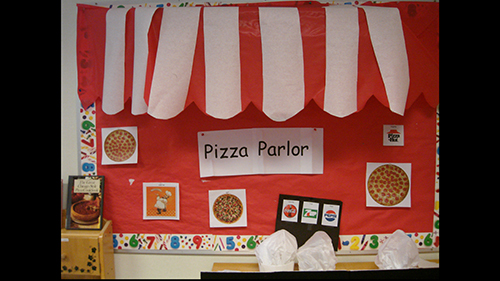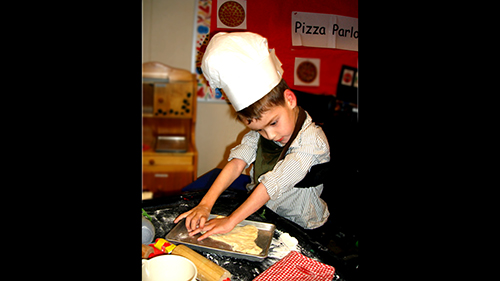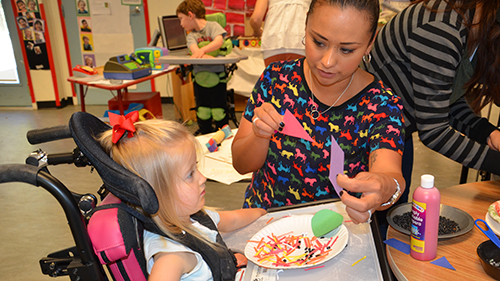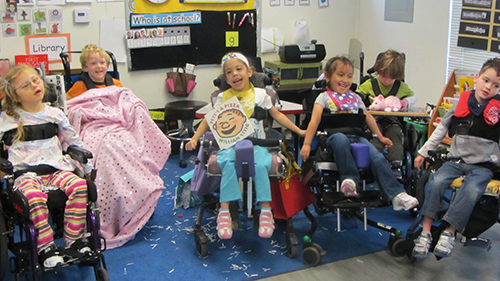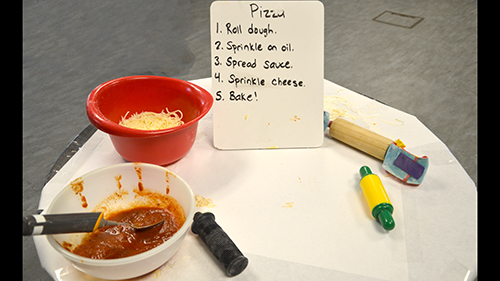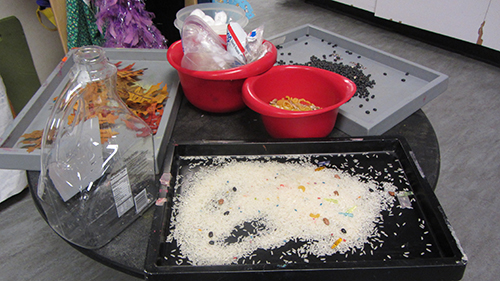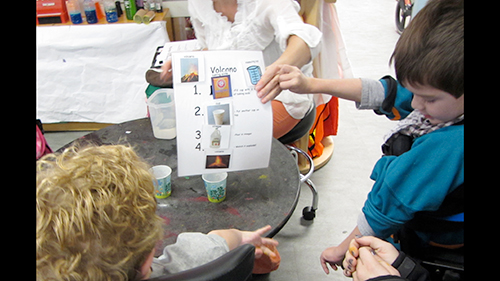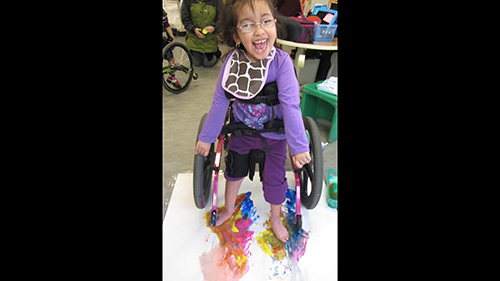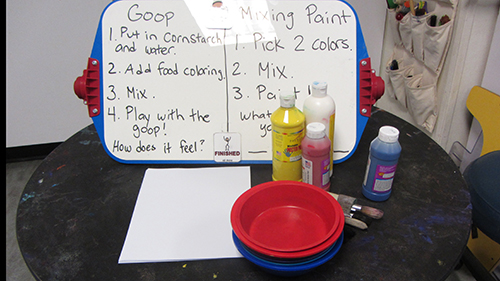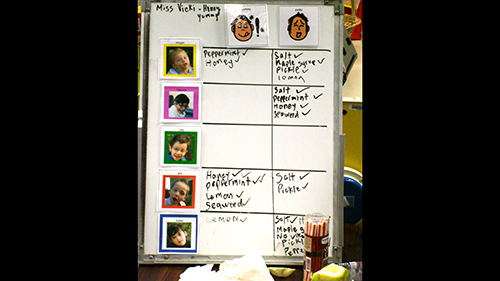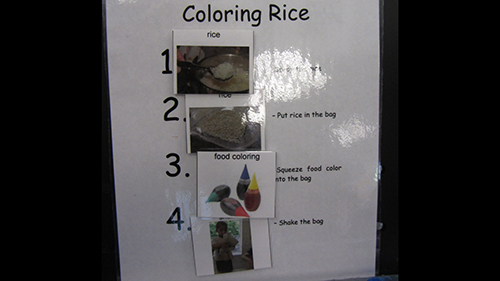Bakery
During Bakery theme students put on chef hats and aprons and use a variety of adapted cooking tools to create pretend cookies, cakes, and other baked goods. At the end of the week, students bake and decorate real cookies to enjoy together, following a simple recipe with picture supports.
Other students choose to be customers, selecting from a list of available items to place an order, while a friend works the cash register. This cafe menu with picture supports gives students the chance to independently read and decide what they want from the menu, while the child at the cash register experiences additional money and counting skills.
Adam uses a switch placed at his stomach and plugged into an AbleNet Power Link, which makes any electronic device switch accessible, to mix up the pretend cake batter.
A simple cake recipe that the teacher can read to the student. Students get to observe how to read a list and follow the directions.
The students enjoy mixing up flour and water and then taking it to the kitchen to put in the real oven. The concept focus of the week is hot and cold. Ms. Elisa goes to the kitchen with Amber and Phoebe and reminds them that an oven (when turned on) can get very hot so a grown-up should always be with you when you want to go to the oven.
As part of the theme, students visited a local bakery shop. Roman rolled out the dough and then used cookie cutters to make heart shaped cookies. At the end of the field trip everyone had a cookie to eat.
Cannon worked very hard at the bakery shop rolling out the dough. Phew, rolling out cookie dough takes a lot of work!
Beauty Parlor/Barber Shop
During the Beauty Parlor/Barbershop theme, students get to experience being a stylist or a customer at a salon or barbershop. One year, the students loved this theme so much, their families organized a group after school outing to a local salon and they all got their hair cut together!
Students have several roles to choose from during this thematic unit including, washing hair by using a spray bottle, cutting hair with play scissors (scissors with no blades), or sitting in the ‘spa chair.’ At the art table students spray shaving cream over paper and make designs with their hands in the cream.
Cannon pretends to be the receptionist, charging customers for their haircut and scheduling appointments with the stylist.
An important role at the beauty parlor is the person who cleans up the hair. Aidan sweeps the floor to clean up the pretend mess.
Young children often have adults grooming them in passive ways. The Beauty Parlor/Barbershop theme had students actively directing others and involved in brushing, cutting, blow-drying, and commenting on the grooming process.
Students gain self-confidence and a positive self-image by learning more about the grooming process and how they can play an active role in it.
Camping
Let’s go camping! The students work as a team to pack up the pretend car (the wagon) with all the things they will need for the trip. Once they make it to the campsite, students can pitch the tent, gather firewood, do some cooking over the camp stove, or even get in the tent and tell stories.
A variety of camping supplies are placed in the pretend play area, including a bag, pot, canned food, and map. Students pack these supplies up as they head out to the pretend campsite.
This CheapTalk 8 has pre-programmed messages that allow the students to use vocabulary and phrases related to camping. By activating these messages they are able to act out a certain play script while also telling their teacher what they want to do.
For the concept focus students learn about things that are hard and soft. Abigail is touching the soft pillow. She will be sure to pack that along with her when she heads out to the camping site.
Sometimes the students like to turn out the lights and pretend it’s nighttime, crawl into the tent, and snuggle up in a soft sleeping bag.
It’s a bear! Adam and Jet pretend to be some bears knocking on the tent door. At Storytime, the students read the book We’re Going on a Bear Hunt, by Michael Rosen.
Cannon found a tree while looking for firewood (it’s really the old Christmas tree). He uses the Usborne’s First Thousand Words book to tell Ms. Janelle what he wants to do with the tree.
At the end of the week students can roast real marshmallows over a ‘fire’ (5-6 candles placed in a ball of playdough) for a real camping treat.
At the art center students paint a tree mural. Students learn that when we go camping we may see lots of trees in the forest.
Concert
In order to get the preschoolers ready for the Annual Bridge School Benefit Concert, the preschool classroom is set up to look like a concert venue. Students get to act out the different roles people play at the concert or any other musical event.
Musical instruments and microphones are available on the ‘stage’ for the students to rock out! Other students choose to be stagehands, helping to pull props on and off the ‘stage’ and work the ‘stage lights.’
Many of the musical instruments are adapted so they can be accessed by a switch. The Music Machine, by Enabling Devices, holds an instrument by the mounting arm. When Aidan activates the red jellybean switch plugged into the Music Machine, the mounting arm moves up and down causing the tambourine to shake and make music.
Jackson works the concession stand where students can order pizza, ice cream, or a drink. Using the Tobii with a customized page set, Jackson is able to ask the customer what they want to order and then tell them the price.
At the art table, students make and decorate their own shakers by filling recycled containers with beans or rice. Students use these instruments during Music, when they also have the chance to share their favorite songs. Amber chose to decorate her shaker with stickers. The pipe cleaner handle is easily adapted to fit the best shape for a student to hold.
During Storytime, students read ‘If You Bring Storyfriend to the Concert,’ written by the staff and based off the If You Give a Mouse a Cookie, by Laura Numeroff, series. The students learn in another activity all the things they can expect to see, hear, and taste at the concert with their friend Storyfriend as the main character.
Construction
The Construction Worker unit is full of tools and trucks. Many students have family members who work in construction or have seen construction sites near their homes. They feel proud to be dressing up and working, just like other grown-ups around them.
Students use different play tools to build or repair buildings made from all sorts of materials (boxes, parachute, blocks, etc.).
Building a TALL tower of boxes is one of the students’ favorite activities. The best part is knocking it down! During art, students can also tape these boxes together and paint them, making box houses.
Don’t forget your reflective construction gear. Cannon is ready with his construction worker vest and toolkit to start building.
Roman asked to get in the swing and be the demolition ball. He knocked a soft tower of blocks down with the help of his friend Cannon.
The students especially enjoy playing with all the different construction trucks- dump truck, digger, bulldozer, crane, etc. Aidan moves the dump truck full of ‘rocks.’ This dump truck’s remote control has been adapted so that the four controls (forward, backward, up, and down) correspond to four switch ports. The switches have been plugged into a 4-switch in-line array purchased from Enabling Devices.
Roman studies the crane that lifts the building materials on our pretend construction site. This crane has been picking up and moving Lego pieces.
At Outside Time, Roman took the same crane onto the playground to build a pretend building on the play structure.
Safety first! Niels checks out his hard hat to make sure it fits before heading to the construction site to do some work.
During music the students sing ‘Johnny Works with One Hamme’ which also reinforces counting concepts. Many of the tools have been adapted to allow students to independently hold and manipulate the materials. This hammer has a rubber band support so that students can hold the prop on their wrist and hammer in the pretend nail.
The bookshelf is full of informative books on construction sites, as well as fictional stories with some favorite, familiar characters (i.e. Bob the Builder). At Storytime students read Building a House, by Byron Barton, that uses appropriate preschool age language and pictures to describe how construction workers build a house.
Dinosaurs
Dinosaurs and animals that lived long ago often fascinate children. During Dinosaur theme students get to act out being an archeologist who digs for the bones and the actual dinosaurs big and small.
The pretend play area includes blow up dinosaurs, painted backdrops, and a tent. The tent is used for the archeologists to sleep in while on a pretend dig for dinosaur bones.
Students dig through beans and rice to find dinosaur bones (which are really Q-Tips). Then they glue the bones on a black piece of paper to study them. Written instructions are helpful for both the students and assisting staff while playing at this station.
Computer activities about dinosaurs are made available on the Tobii in the pretend play area. Students can touch the screen to activate the activity and learn more about dinosaurs.
At the art table, students make paper plate dinosaurs. They glue on 1 head, 2 feet, and 1 tail, then decorate with paint, glitter, and sequins.
Jackson calls the museum to find out more about dinosaurs and what they ate. After he got off the phone with Ms. Holly, he fed his toy dinosaur some pretend food. The students also enjoyed inviting the dinosaur to a tea party.
During Storytime, students read the book Dinosaurs, Dinosaurs, by Byron Barton. They learned that some dinosaurs had horns. At the pretend play area, Arman tried on a dinosaur hat with horns.
Using a pre-programmed Step-By-Step, Amber told Ms. Kristal how to take care of the dinosaur. She told Ms. Kristal to feed the dinosaur and put him to bed.
The students named this big red dinosaur Bob. Bob even went to Outside Time for a game of chase. At cleanup time the students made sure Bob made it back to his tent to sleep.
Doctor
The Doctor theme allows students to choose between being a doctor, nurse, patient, or receptionist. Many students have been to the doctor’s office before and enjoy taking on the role of the doctor or nurse.
Students can take on many roles during the doctor theme. Some may be the receptionist and answer calls while others use the various doctor tools and take care of a teacher or stuffed animal.
After the teacher has been called into one of the patient rooms, the nurse and/or doctor may take a temperature, give a shot, listen to the heart, or even order an X-Ray.
Clipboards with paper are kept available so students can write down any important information, schedule an appointment on a calendar, or write a report about the patient- all of which help reinforce literacy skills.
Cannon uses all kinds of instruments seen in the doctor’s office. He uses his VOCA, mounted on the table in front of him, to tell Ms. Janelle what she needs- a shot or some medicine.
Students learn about ways to keep their bodies healthy for the concept focus. Information from home, provided on the I Know About That notes, also describes ways students keep their bodies healthy at home (exercise, eat healthy foods, etc.).
Savannah takes one of her vocabulary word icons and turns it into a costume. She wanted to wear this icon to let everyone know she is the doctor.
At Storytime, students read Usborne’s First Experiences book, Going to the Doctor. Later they can use the book at Centers to remember different things that happen at the doctor’s office.
Grocery Store
During the Grocery Store theme students can go shopping or be a grocery clerk. Food items, many of which are empty food containers and boxes, are placed around the “store” according to food group (dairy, fruits and vegetables, bread, meat, and sweets).
Aidan chooses what items to put in his shopping cart. As part of the grocery store backdrop, logos from the students’ favorite grocery stores hang around the room for them to practice reading.
Joey rings up and bags the groceries Ms. Joy wants to buy. He uses toy money and is able to practice some counting skills, while also learning about coins and bills.
Arman pretends to drive to the grocery store, then picks up a shopping cart to take around the store.
At the art table, students can either make grocery lists by cutting up food advertisements, or fruit and veggie prints. Jet is using a carrot dipped in paint to make his fruit and veggie painting.
At Music, students use the food items found in the pretend grocery store to sing the song ‘Peanut Butter and Jelly.’
For the concept focus, students make a graph of things you can eat and things you cannot eat. They pull an item from a basket and decide which side of the graph it belongs on. Students can even walk around the room and find items to add to the graph. The students always laugh when things you cannot eat are pulled out of the basket!
As part of the Grocery Store theme, students take a field trip to a local grocery store. Before going they made a shopping list of what they needed to make fruit smoothies.
While positioned in his hands- free support walker Jet walked around the whole grocery store. He was able to tell his teacher where he wanted to go and walked right up to different food displays to find out more.
Outer Space
To infinity and beyond! For Outer Space week, the classroom staff constructs a spaceship (large enough to fit at least 2 hands-free support walkers) in the middle of the classroom, and the pretend play area becomes the surface of the moon.
At the pretend play area a backdrop is set up with different planets, stars, and other outer space images for students to study. Costumes, such as an astronaut helmet are set out. There are even some ‘moon robots’ for students to control through IR once they reach the ‘moon.’
Props such as headphones, buttons and communication devices with pre-recorded sci-fi sound effects, and freeze-dried astronaut food help students take on roles of astronauts, ground controllers, and even aliens!
Arman and Amber blasted off to the moon in the spaceship. Once they reached the moon they took the moon buggy for a ride.
At the art table Savannah made her own space helmet. Then she got ready to be an astronaut in her shiny space suit (shiny, mylar paper) and helmet.
Astronaut Jackson cleans the space ship after it returns from the moon. It was so dirty with moon dust!
Astronaut Phoebe uses a walkie-talkie to radio down to the space office. She wants them to know she made it to the moon!
At the art center students can also paint a planet mural. While positioned in his hands-free support walker, Adam is able to get right up to the mural and use his hands to paint. Many students are better able to access painting activities when the paper is hung up on the wall. The butcher paper allows students to use wide, large movements to create a painting that can later be cut up into smaller sizes if desired.
Pizza Parlor
Pizza Parlor is all about pizzas and who doesn’t love pizza? Students get to order, cook, serve, deliver, and even eat pizza.
The pretend play station is set up so that students really feel like they are in a pizza parlor, whether as a pizza maker or a customer.
Some students answer the phone to take pizza orders. A checklist with all the toppings the customer ordered is close by for students to take notes. A play pizza with all kinds of toppings that Velcro on top is available for students, this pizza can also get cut up into triangle pieces.
At the pizza dough station students mix flour and water to make the dough. Real pizza dough is also available for students to roll out and even taste.
Once the pizza is ready students can push the delivery truck to deliver the pizza to the customer. While positioned in their hands-free support walkers students can use their feet to push the truck along on the ground.
At the art table students make a shape pizza. Shapes are also the concept focus of the theme, particularly circles (which is the whole pizza) and triangles (which is a slice of pizza). Phoebe makes a choice from two shapes to put on her pizza. Phoebe learns more about shapes as Ms. Laura labels each one she can choose from.
At Storytime, students read the book ‘Pete’s a Pizza,’ by William Steig. They act out making themselves into a pizza just like Pete. It’s a classroom favorite, especially because of how messy it gets!
Abigail is hard at work spreading the pizza sauce. Taste tests are encouraged for those who want to!
The Music Machine, from Enabling Devices, holds a cup with cheese. Some of the bottom of the cup has been cut out so that the cheese can come through. When Savannah touches the jellybean switch the mounting arm moves up and down, sprinkling cheese on the pizza.
YUM, pizza! After the pizza comes out of the oven, students enjoy tasting the pizza they made or sharing it with a friend or teacher.
Scientist
As scientists, students investigate their world through their five senses and by conducting experiments. The “lab” or pretend play area is set up with a variety of activities that encourage students to use their hands, ask questions, and find out more.
At the table addressing the touch sense, students have different textures to sift through including dried rice, beans, leaves, sand, etc.
Jackie sifts through the soil to find some toy insects. Then she uses the magnifying glass to look at and study them, just like a scientist.
Different experiments are set out each day for the students to discover. The directions are written out with picture supports so students can practice reading the steps.
Adam holds up the directions for the volcano experiment. By mixing water and baking soda the students get to see the mixture bubble over the cup just like a volcano!
During the Scientist theme there is lots of mixing! While reading ‘Mouse Paint,’ by Ellen Stoll Walsh, the students read how the mice mix paint with their feet to make new colors. At the art table, Savannah picks two paint colors to mix with her feet and comes up with a new color.
Also at the art table, students can make ‘goop’ by mixing cornstarch and water. The students then feel or touch the goop, which feels both like a liquid and a solid.
Another sense addressed is taste. Students taste honey, salt, peppermint sticks, lemons, pickles, and dried seaweed then mark whether it was ‘yucky’ or ‘yummy’ on the taste test graph.
Another experiment is coloring rice. Food coloring is dropped into a bag of rice to change its color. Color words are addressed later in the day during Music when the students sing a song about the colors of the rainbow.

